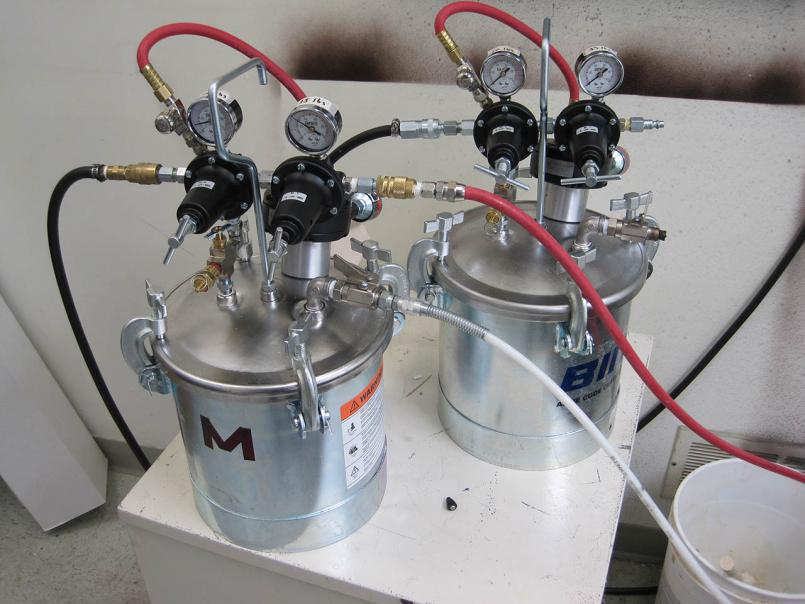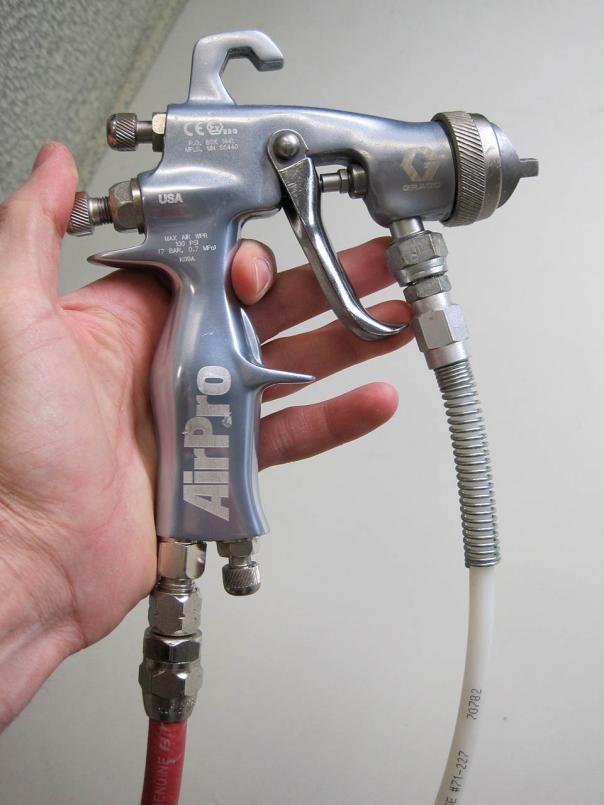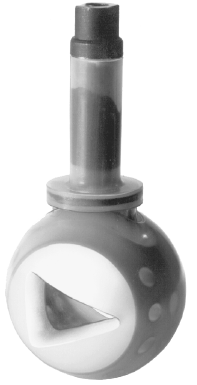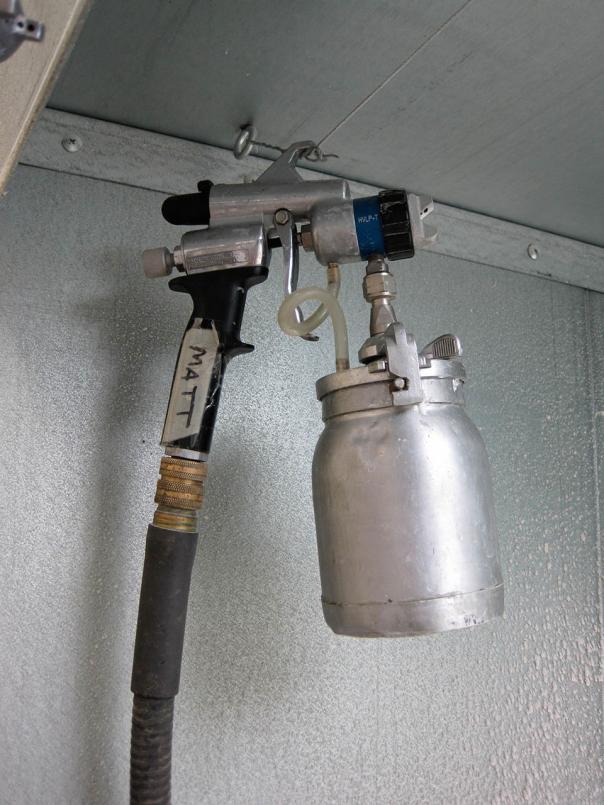|
|

|
Porsche, and the Porsche crest are registered trademarks of Dr. Ing. h.c. F. Porsche AG.
This site is not affiliated with Porsche in any way. Its only purpose is to provide an online forum for car enthusiasts. All other trademarks are property of their respective owners. |
|
|
  |
| lotus_65 |
 Apr 8 2010, 10:08 AM Apr 8 2010, 10:08 AM
Post
#1
|
|
Senior Member    Group: Members Posts: 1,608 Joined: 21-March 05 From: minneapolis, mn Member No.: 3,795 Region Association: Northstar Region |
Hi good people, you are the best resource I have at hand, so I'm throwing this out to you all:
At work, I/we utilize 2-2.5 gallon pressure pots that hold 2 similar liquid (gloss & matte) materials (basically glue) that we use to coat our products with an hvlp gun using 10lbs pressure in our spray booth. Some clients want a combination of the 2 coatings to create a 3rd semi-gloss/satin finish. Best case scenario is that I could mix/blend the 2 in-line somehow, because we could easily customize the coatings per the client's request. It's logical to me to relate these 2 liquids as something similar to hot and cold water, and I want to be able to coat my products with hot, warm or cold liquid using a manifold to dial the percentages. As I'm writing this, I feel like it would be ideal to have some type of ball valve at the gun, receiving the two fluid lines, and allowing me to dial the mix right there. Does anyone know what I'm trying to say, and have a direction to share? Thanks- paul |
| 76-914 |
 Apr 8 2010, 10:40 AM Apr 8 2010, 10:40 AM
Post
#2
|
|
Repeat Offender & Resident Subaru Antagonist           Group: Members Posts: 13,495 Joined: 23-January 09 From: Temecula, CA Member No.: 9,964 Region Association: Southern California 
|
Hi good people, you are the best resource I have at hand, so I'm throwing this out to you all: At work, I/we utilize 2-2.5 gallon pressure pots that hold 2 similar liquid (gloss & matte) materials (basically glue) that we use to coat our products with an hvlp gun using 10lbs pressure in our spray booth. Some clients want a combination of the 2 coatings to create a 3rd semi-gloss/satin finish. Best case scenario is that I could mix/blend the 2 in-line somehow, because we could easily customize the coatings per the client's request. It's logical to me to relate these 2 liquids as something similar to hot and cold water, and I want to be able to coat my products with hot, warm or cold liquid using a manifold to dial the percentages. As I'm writing this, I feel like it would be ideal to have some type of ball valve at the gun, receiving the two fluid lines, and allowing me to dial the mix right there. Does anyone know what I'm trying to say, and have a direction to share? Thanks- paul Your looking for a mixing valve sometimes referred to as an Ortega valve. Is this something that you want to mount to a spray gun or remote? This can be fabbed up with 3 valves a tee and some elbows and nipples, in the fashion of a torch handle. 1/4" male-female brass ball valves should work fine as long as your media is fieindly to teflon. The seals between the brass and SS ball are teflon. Needle valves are the only type truely recommended for metering but ball valves should work if the flow rate isn't too great. The problem with any non-needle valve used for metering is unwanted turbulance and cavitaion (disturbance in flow characteristics). Watts Co. makes these valves. If you can't locate them PM me. Kent |
| Mike Bellis |
 Apr 8 2010, 01:38 PM Apr 8 2010, 01:38 PM
Post
#3
|
|
Resident Electrician      Group: Members Posts: 8,345 Joined: 22-June 09 From: Midlothian TX Member No.: 10,496 Region Association: None 

|
(IMG:style_emoticons/default/agree.gif)
Needle valves would be the best mixing valve. The problem I see is with the callibration of the mix. A pressure gauge of some type could be used per liquid, however if this is a resin you may gum up the gauge. Some sort of pressure isolater would be needed to keep it off the gauge diaphram. If you could get a flow meter and callibrated can you could just spray each one into the can to callibrate. Other wise it may be a best guess callibration. You will not get good mix callibration for ball valves. |
| rick 918-S |
 Apr 8 2010, 02:00 PM Apr 8 2010, 02:00 PM
Post
#4
|
|
Hey nice rack! -Celette                Group: Members Posts: 20,443 Joined: 30-December 02 From: Now in Superior WI Member No.: 43 Region Association: Northstar Region 

|
You may need to look at something like the two part adhesive products use. Some type of twist mixer for the fluid to flow through to pre mix it before it comes out the spray tip. This may require a pressure pot style feed rather than a syphon feed as you may be a better mix. Interesting puzzle.
|
| charliew |
 Apr 8 2010, 02:10 PM Apr 8 2010, 02:10 PM
Post
#5
|
|
Advanced Member     Group: Members Posts: 2,363 Joined: 31-July 07 From: Crawford, TX. Member No.: 7,958 |
Also you might want the mixing to happen pretty close to the gun so you won't have too much waste when you switch back and forth. When I used to use a flattening agent in urethane auto paints it would take quite a bit of the flattener to get the sheen I was after. The temp and humidity also made a big difference in the outcome.
|
| rwilner |
 Apr 8 2010, 05:30 PM Apr 8 2010, 05:30 PM
Post
#6
|
|
No Ghosts in the Machine    Group: Members Posts: 953 Joined: 30-March 10 From: Boston, MA Member No.: 11,530 Region Association: North East States |
(IMG:style_emoticons/default/agree.gif) Needle valves would be the best mixing valve. The problem I see is with the callibration of the mix. A pressure gauge of some type could be used per liquid, however if this is a resin you may gum up the gauge. Some sort of pressure isolater would be needed to keep it off the gauge diaphram. If you could get a flow meter and callibrated can you could just spray each one into the can to callibrate. Other wise it may be a best guess callibration. You will not get good mix callibration for ball valves. +1, for mixing valves, although I'm not sure I agree with the above. In my experience: needle valves are better at constant pressure applications, which is better for mixing and controlling gas flow. ball valves are better at constant volume applications, which is better for mixing and controlling liquid flow. All that said, only one way to find out....try it! |
| zonedoubt |
 Apr 8 2010, 05:45 PM Apr 8 2010, 05:45 PM
Post
#7
|
|
Canadian Member    Group: Members Posts: 668 Joined: 14-May 03 From: Vancouver, BC Member No.: 696 Region Association: Canada |
Ball valves aren't ideal for flow control unless they have a characterized ball or seat. A multi-turn valve like a needle or globe is best.
|
| jd74914 |
 Apr 8 2010, 06:28 PM Apr 8 2010, 06:28 PM
Post
#8
|
|
Its alive     Group: Members Posts: 4,780 Joined: 16-February 04 From: CT Member No.: 1,659 Region Association: North East States |
How accurate would you like it to be and how much do you really want to spend (I know its always as little as possible)?
How viscous is the fluid? Using needle valves is a good suggestion (ball valves would work too, they just aren't as controllable, think 1/4 or 1/2 turn to open versus 8 turns for some needles), though I would personally attack the problem in a different manor. I would use orifice plates and two regulators or I-P transducers to change the pressure on the pots. Orifices are easily characterized and by changing the pressure on the inlet (so changing the paint pot pressure) and keeping the outlet pressure constant you can easily change the flow rate through the orifice. The flow rate is simple to calculate as the physics behind them are very well know (and orifice flow calculators abound on the internet). Using orifices would allow for very precise metering of flow, and would make it very easy to record specific customers' recipes since all you need to record is the orifice size and pressure. As an added benefit they are much easier to clean and less expensive to replace than needle valves. Incorporating two I-P transducers, which are essentially computer controlled regulators, would allow you to tune the system to always have the perfect pressure on the outlet side by regulating the inlet in accordance to demand. That said, they are somewhat finicky and super expensive so normal regulators would probably work better. |
| lotus_65 |
 Apr 8 2010, 07:44 PM Apr 8 2010, 07:44 PM
Post
#9
|
|
Senior Member    Group: Members Posts: 1,608 Joined: 21-March 05 From: minneapolis, mn Member No.: 3,795 Region Association: Northstar Region |
QUOTE nice. thanks. i get about 10% of it, so i'll get studying. i'll get flow rates and the rest of the specs tomorrow, it's busy now--- i was about to post this and i couldn't. now that i'm finally home: (and i'll post pics tomorrow.) jd74914, it sounds like your metering at the pot right? ideally i need it at the gun, or feeding one liquid line to the gun. it'd be good to spec the customers mix too, but we're a production house mostly, and only want to offer a limited number of options (working with artists, here). ideally, 5 options from gloss to matte. the liquid is heavy glue cut with distilled water. it has sediment and the pressure pots have agitators that warm the product too. more ina minute This post has been edited by lotus_65: Apr 8 2010, 08:26 PM |
| lotus_65 |
 Apr 8 2010, 08:43 PM Apr 8 2010, 08:43 PM
Post
#10
|
|
Senior Member    Group: Members Posts: 1,608 Joined: 21-March 05 From: minneapolis, mn Member No.: 3,795 Region Association: Northstar Region |
Ball valves aren't ideal for flow control unless they have a characterized ball or seat. A multi-turn valve like a needle or globe is best. (IMG:style_emoticons/default/051103-stupid4.gif) will you please give me more. diagrams on a website? but i would guess the glue will set up in any needle situation, we couldn't use the fluid quick-release due to material drying. thanks |
| Porcharu |
 Apr 8 2010, 09:51 PM Apr 8 2010, 09:51 PM
Post
#11
|
|
Senior Member    Group: Members Posts: 1,314 Joined: 27-January 05 From: Campbell, CA Member No.: 3,518 Region Association: Northern California |
I used to deal with picoliters - a couple of gallons is WAY out of my league.
Steve |
| lotus_65 |
 Apr 9 2010, 06:47 AM Apr 9 2010, 06:47 AM
Post
#12
|
|
Senior Member    Group: Members Posts: 1,608 Joined: 21-March 05 From: minneapolis, mn Member No.: 3,795 Region Association: Northstar Region |
here's our setup:
we run 35lbs of air, 10lbs on the fluid.  nice gun with a .042 nozzle.  there's gloss and a satin in the two pots. i want to run gloss and matte, and mix at the gun or to the line. i looked up the ortega valve and it looks promising, though physically too large to have mounted to the gun. |
| lotus_65 |
 Apr 9 2010, 06:49 AM Apr 9 2010, 06:49 AM
Post
#13
|
|
Senior Member    Group: Members Posts: 1,608 Joined: 21-March 05 From: minneapolis, mn Member No.: 3,795 Region Association: Northstar Region |
|
| rwilner |
 Apr 9 2010, 12:13 PM Apr 9 2010, 12:13 PM
Post
#14
|
|
No Ghosts in the Machine    Group: Members Posts: 953 Joined: 30-March 10 From: Boston, MA Member No.: 11,530 Region Association: North East States |
How accurate would you like it to be and how much do you really want to spend (I know its always as little as possible)? How viscous is the fluid? Using needle valves is a good suggestion (ball valves would work too, they just aren't as controllable, think 1/4 or 1/2 turn to open versus 8 turns for some needles), though I would personally attack the problem in a different manor. I would use orifice plates and two regulators or I-P transducers to change the pressure on the pots. Orifices are easily characterized and by changing the pressure on the inlet (so changing the paint pot pressure) and keeping the outlet pressure constant you can easily change the flow rate through the orifice. The flow rate is simple to calculate as the physics behind them are very well know (and orifice flow calculators abound on the internet). Using orifices would allow for very precise metering of flow, and would make it very easy to record specific customers' recipes since all you need to record is the orifice size and pressure. As an added benefit they are much easier to clean and less expensive to replace than needle valves. Incorporating two I-P transducers, which are essentially computer controlled regulators, would allow you to tune the system to always have the perfect pressure on the outlet side by regulating the inlet in accordance to demand. That said, they are somewhat finicky and super expensive so normal regulators would probably work better. This is a good approach. You could use panel-mounted PID controllers to control the position of the I to P transducers. I have had good luck with Red Lion controllers -- reliable and cheap. Although between I to P transducers, pressure transmitters, orifices (you'd probably want stainless), etc...things are starting to get expensive. |
| underthetire |
 Apr 9 2010, 02:24 PM Apr 9 2010, 02:24 PM
Post
#15
|
|
914 Guru      Group: Members Posts: 5,062 Joined: 7-October 08 From: Brentwood Member No.: 9,623 Region Association: Northern California |
How accurate would you like it to be and how much do you really want to spend (I know its always as little as possible)? How viscous is the fluid? Using needle valves is a good suggestion (ball valves would work too, they just aren't as controllable, think 1/4 or 1/2 turn to open versus 8 turns for some needles), though I would personally attack the problem in a different manor. I would use orifice plates and two regulators or I-P transducers to change the pressure on the pots. Orifices are easily characterized and by changing the pressure on the inlet (so changing the paint pot pressure) and keeping the outlet pressure constant you can easily change the flow rate through the orifice. The flow rate is simple to calculate as the physics behind them are very well know (and orifice flow calculators abound on the internet). Using orifices would allow for very precise metering of flow, and would make it very easy to record specific customers' recipes since all you need to record is the orifice size and pressure. As an added benefit they are much easier to clean and less expensive to replace than needle valves. Incorporating two I-P transducers, which are essentially computer controlled regulators, would allow you to tune the system to always have the perfect pressure on the outlet side by regulating the inlet in accordance to demand. That said, they are somewhat finicky and super expensive so normal regulators would probably work better. This is a good approach. You could use panel-mounted PID controllers to control the position of the I to P transducers. I have had good luck with Red Lion controllers -- reliable and cheap. Although between I to P transducers, pressure transmitters, orifices (you'd probably want stainless), etc...things are starting to get expensive. We use servo valves a lot for temp mixing. All the electronic stuff is gonna cost, no matter what. I like using the Siemens LOGO smart relay/mini PLC myself. You can program that thing to do almost anything you want, and they are super cheap. http://www.automation.siemens.com/mcms/pro...es/Default.aspx |
| zonedoubt |
 Apr 11 2010, 12:38 PM Apr 11 2010, 12:38 PM
Post
#16
|
|
Canadian Member    Group: Members Posts: 668 Joined: 14-May 03 From: Vancouver, BC Member No.: 696 Region Association: Canada |
(IMG:style_emoticons/default/051103-stupid4.gif) will you please give me more. diagrams on a website? Characterized ball valve has a V-notch or other pattern machined into the ball or its seat. This allows for a better flow characteristic for control applications.  Another problem with ball valves is that media (e.g. paint) can get trapped in the cavities in the valve body. This could be a concern for cross contamination when changing media. There are solutions to address this such as cavity fillers but then you're into a specialty product. I don't know paint sprayer systems but I know valves (my job). |
| rwilner |
 Apr 11 2010, 06:31 PM Apr 11 2010, 06:31 PM
Post
#17
|
|
No Ghosts in the Machine    Group: Members Posts: 953 Joined: 30-March 10 From: Boston, MA Member No.: 11,530 Region Association: North East States |
Another problem with ball valves is that media (e.g. paint) can get trapped in the cavities in the valve body. This could be a concern for cross contamination when changing media. There are solutions to address this such as cavity fillers but then you're into a specialty product. I don't know paint sprayer systems but I know valves (my job). This man speaks the truth. What about diaphragm (or membrane for your EU folks) valves? Multi turn, cleanable, AND he can simply toss and replace the diaphragms if/when they get too contaminated. |
  |
1 User(s) are reading this topic (1 Guests and 0 Anonymous Users)
0 Members:

|
Lo-Fi Version | Time is now: 8th May 2024 - 11:24 PM |
Invision Power Board
v9.1.4 © 2024 IPS, Inc.









